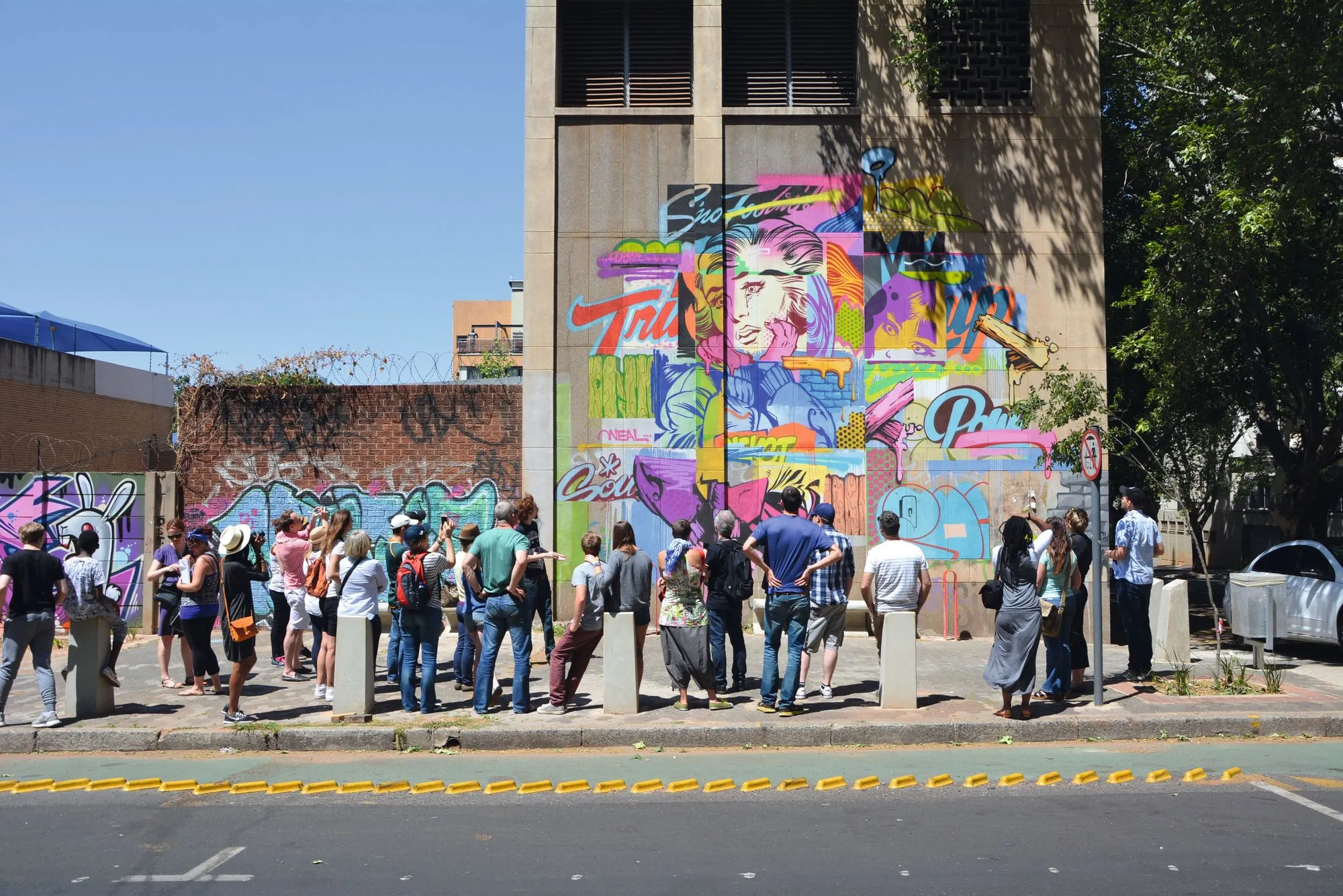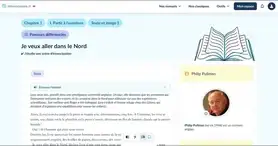Unit 6
Activity 2
Differentiation
Regenerating neighbourhoods
Ressource affichée de l'autre côté.
Faites défiler pour voir la suite.
Faites défiler pour voir la suite.
Group 1 From tags to murals
Each group is in charge of a document. Study it and .
Ressource affichée de l'autre côté.
Faites défiler pour voir la suite.
Faites défiler pour voir la suite.
Text document
Graffiti in South Africa has always been a contentious1 topic. It's been called public art, vandalism, a tool for social change, a gateway to further crime and urban degradation, it's an artform with various symbolic meanings and is only recently experiencing widespread corporate backing and interest
in the public sphere. There are a number of contributing factors towards this, namely graffiti walking tours, brands that make use of the aesthetic in advertising, the role of social media, and rapidly urbanised areas that make use of commissioned graffiti.
By the early 2000s, graffiti had already solidified itself in South Africa with a growing number of artists and graffiti crews in all of its major cities. In Cape Town the graffiti scene was thriving2. Around the time of the 2010 FIFA World Cup, however, the city of Cape Town implemented a series of by-laws to tidy up the city for its esteemed international guests. Interestingly, just before kick-off, legal murals began springing up3 at strategic points all over town in an effort to showcase Cape Town's eclectic community of artists.
An artist who's well known for his commissioned work is Damn Vandal. Legal pieces and murals in the public eye, he believes, have the power to change and uplift the environment. “Whenever I approach homeowners and businesses for their walls, I base it on making the area look better, especially in areas that are run down and derelict.”
Once a crime ridden area, Cape Town's Woodstock now sports a host of street art and public murals. As a medium that extends itself to almost every corner of a city for all to see, graffiti has always been (and probably still is) one of the few true forms of public art in the country. It is a golden artform that can now exist in gallery spaces as well as lower income areas, for all to see and appreciate.
1. controversial. 2. flourishing 3. expanding
By the early 2000s, graffiti had already solidified itself in South Africa with a growing number of artists and graffiti crews in all of its major cities. In Cape Town the graffiti scene was thriving2. Around the time of the 2010 FIFA World Cup, however, the city of Cape Town implemented a series of by-laws to tidy up the city for its esteemed international guests. Interestingly, just before kick-off, legal murals began springing up3 at strategic points all over town in an effort to showcase Cape Town's eclectic community of artists.
An artist who's well known for his commissioned work is Damn Vandal. Legal pieces and murals in the public eye, he believes, have the power to change and uplift the environment. “Whenever I approach homeowners and businesses for their walls, I base it on making the area look better, especially in areas that are run down and derelict.”
Once a crime ridden area, Cape Town's Woodstock now sports a host of street art and public murals. As a medium that extends itself to almost every corner of a city for all to see, graffiti has always been (and probably still is) one of the few true forms of public art in the country. It is a golden artform that can now exist in gallery spaces as well as lower income areas, for all to see and appreciate.
1. controversial. 2. flourishing 3. expanding
“From tags to murals”, Dave Mann, 10and5.com, 2016.


Ressource affichée de l'autre côté.
Faites défiler pour voir la suite.
Faites défiler pour voir la suite.
Group 2 Street Art, a creative revolution
Each group is in charge of one video. Watch it and .
Ressource affichée de l'autre côté.
Faites défiler pour voir la suite.
Faites défiler pour voir la suite.
Mural by Pastelheart, Cape Town, 2013.
Ressource affichée de l'autre côté.
Faites défiler pour voir la suite.
Faites défiler pour voir la suite.
Many times graffiti leads to regeneration, as areas of rampant graffiti draw the attention of developers. It's strange how they overlook abandoned and forgotten buildings for years, like many hijacked buildings in Johannesburg, but once more and more graffiti is painted on it, only then will they feel the need to fix or destroy it.― Cale Waddacor (Author of #GraffitiSouthAfricaBook)
Ressource affichée de l'autre côté.
Faites défiler pour voir la suite.
Faites défiler pour voir la suite.
Questions
You are in charge of one group of documents.
b. What are the ones against it?
1
What type of document is it? What does it deal with?.
2
a. What are the arguments in favour of Street Art?b. What are the ones against it?
3
How has the city of Cape Town evolved over the years?4
What is the impact on the population? Which debate does it raise?Useful vocabulary
This is a text / video presenting…
Unlike before, street art now…
People used to believe street artists were vandals whereas today...
Unlike before, street art now…
People used to believe street artists were vandals whereas today...
Let's talk this out!
Pair work
Mediation
5
What are the similarities and differences?6
Discuss how graffiti has enabled to regenerate South African cities or neighbourhoods.7
Look at the quote above by Cale Waddacor. Explain what he means in your own words.
Your time to shine!
8
Do you believe graffiti is a form of art or a form of vandalism? Choose a picture and write an Instagram post to answer this question.
Useful vocabulary
On the whole…
I agree with the idea that…
Indeed / as a matter of fact, ...
For example / for instance, ...
I agree with the idea that…
Indeed / as a matter of fact, ...
For example / for instance, ...
Ressource affichée de l'autre côté.
Faites défiler pour voir la suite.
Faites défiler pour voir la suite.
Toolbox
- shocking / subversive (adj.)
- tag / graffiti (n.)
- poverty / unemployment (n.)
- improve / embellish (v.)
- tackle an issue /ˈɪʃuː/ (v.)
Ressource affichée de l'autre côté.
Faites défiler pour voir la suite.
Faites défiler pour voir la suite.
Crossing words
Select eight important words you have learnt in this unit so far. Write a definition for each and make a crossword.Ressource affichée de l'autre côté.
Faites défiler pour voir la suite.
Faites défiler pour voir la suite.
La traduction de « permettre »
- permettre = autoriser ou donner la permission → allow (to + V) / authorise (to + V) / permit (to + V)
- permettre = rendre capable ou possible → enable (to + V) / make possible (for + noun) (to + V)
- se permettre = avoir les moyens (financiers) → afford / have the financial means to / the money to
- se permettre = avoir l'audace → take the liberty of doing something / allow oneself (to + V)
- si je peux me permettre → If I may...
Ressource affichée de l'autre côté.
Faites défiler pour voir la suite.
Faites défiler pour voir la suite.
Le prétérit
- Base verbale + ed (affirmation)
- did / didn't + V (questions et négations) ⚠
- Pour parler d'un évènement passé, daté, terminé.
- Toujours utilisé avec une date passée : yesterday, last week / month / year, ago…
•
Ressource affichée de l'autre côté.
Faites défiler pour voir la suite.
Faites défiler pour voir la suite.
Over to you!
Une erreur sur la page ? Une idée à proposer ?
Nos manuels sont collaboratifs, n'hésitez pas à nous en faire part.
j'ai une idée !
Oups, une coquille


